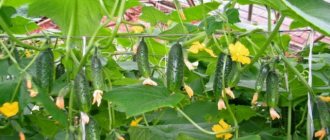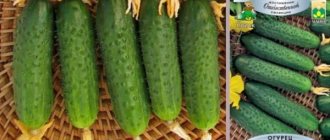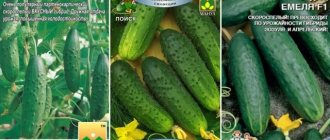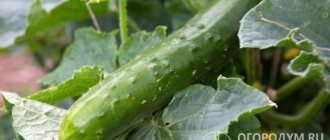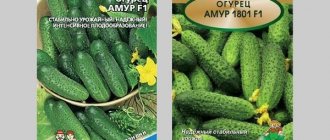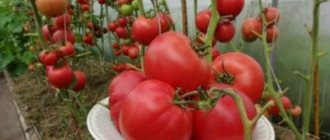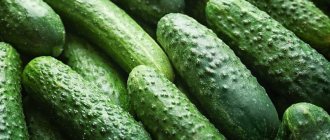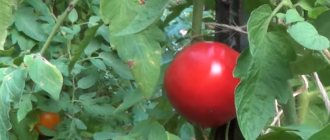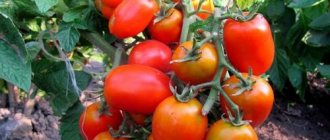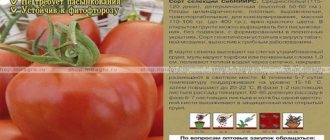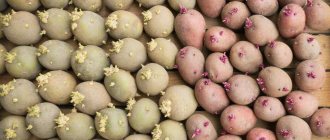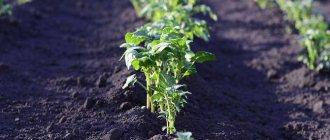Description of the cucumber variety Generalsky F1
Generalsky F1 is a new variety of premium super-tufted cucumbers with a self-regulating type of branching, in which high crop loads on the stem prevent the rapid formation of lateral shoots.
After the cucumbers, which have ripened on the main stem, are harvested, the side shoots accelerate the growth rate. Self-regulating branching saves a lot of time, since the need to pinch side shoots is almost completely eliminated.
The seeds were bred by breeders from domestic agriculture. The description of General F1 cucumbers states that they are capable of bearing fruit until late autumn, and a high yield will be guaranteed in any conditions. Photos and reviews of General's cucumbers indicate that the variety is considered one of the most highly productive super-beamed early ripening gherkin hybrids.
The fruits are dark green cucumbers, small in size, reaching a length of 10 - 12 cm and 3 cm in diameter. Their weight is approximately 80 - 100 g. On the surface of the fruits there are large tubercles located with an average frequency. At the beginning of ripening, cucumbers are characterized by abundant pubescence on the skin.
Cucumber bushes have a female type of flowering, are tall (up to 2 m) and climbing, and are distinguished by long side shoots. There are about 12 ovaries in one node. With the seedling method of planting, the first cucumbers appear in June.
Care
Basic requirements for caring for the Generalsky hybrid:
- Water generously using warm, settled water. The frequency of watering is determined by weather conditions. The soil must be kept moist at all times;
- To get a good harvest during the entire growing season, 3-4 fertilizing with organic fertilizers and mineral complexes is carried out;
- Self-regulating branching avoids pinching;
- The formation of a supertuft bush is carried out exclusively in one stem. The lower 3-4 nodes are removed. This will allow the remaining ovaries to receive a sufficient amount of nutrients;
- The bush must be tied to a trellis. When the plant reaches a height of two meters, pinch off the top. This will allow the existing ovaries to mature;
- As soon as almost all the greens have been collected from the main stem, the crop is fertilized with fertilizer containing nitrogen. This is necessary for the active formation of young shoots;
- The greens will fill up faster if you install a barrel filled with fermented grass or manure in a greenhouse structure;
- They also carry out preventive treatments of bushes to prevent the appearance of pests;
- Ripe greens are collected every day.
Taste qualities of cucumbers
In reviews of cucumbers of the Generalsky F1 variety, summer residents write that the pulp of the fruit is dense, crispy and very juicy, has no voids, is colored a creamy-greenish tint and has a characteristic fresh and pleasant aroma. The Generalsky F1 variety is famous for its high taste qualities and thanks to this it has managed to gain many fans, despite the fact that it is a new product.
Cucumbers can be eaten fresh, salted and canned. Undeveloped small seeds give them an appetizing appearance in salads and vegetable slices, and due to the delicate structure of the pulp, lightly salted gherkins are quickly soaked in brine. Small sizes allow you to pickle cucumbers either sliced or whole.
Features of describing a hybrid culture
The Generalsky F1 cucumber was bred by breeders of the Barnaul company Ural Summer Resident. The seeds were released on the market in 2015. The hybrid is not yet listed in the State Register of the Russian Federation. The originator allows the cultivation of the crop in all regions of the country.
Attention! In the manufacturer's product catalog, cucumber belongs to the Premium category. A bag of 5 seeds costs about 100 rubles.
The main feature of the variety is a large number of ovaries in bunches. In some of them, up to 12 colors are formed. The cucumber is distinguished by its intense branching. However, it is not necessary to step it up. The culture can independently regulate the development of lateral shoots. Their growth is inhibited when the main stem is overloaded.
The cucumbers themselves are of the gherkin type. They are neat in appearance - this is noticeable in the photo. In diameter - up to 3 cm. Covered with thin skin with strong pubescence. Inside the fruits are dense, have no voids, the seeds are undeveloped and small. The cucumber pulp is crunchy.
| By type of growth | Strongly climbing |
| By type of branching | Strongly branched |
| By type of pollination | Parthenocarpic |
| Planting scheme | 70×50 cm |
| Weight, length and shape of the fruit | 80-90 g, 10-12 cm, short, cylindrical, dark green, coarsely tuberous |
| Ripening period | Early ripening (44-54 days) |
| Usage | Universal |
| Drop off point | Universal |
| Diseases | Genetically immune to most garden diseases |
| Flowering type | Female |
| Productivity | In the spring-summer turnover in the exhaust gas - up to 40 kg/m2, in the greenhouse - more than 40 kg/m2, in the summer-autumn turnover the figures are lower |
Pros and cons of the variety
The description and photo of the Generalsky F1 cucumber variety allow us to draw conclusions about its pros and cons. Advantages of the variety:
- high yield of the variety (40 kg per 1 sq.m);
- early ripening of cucumbers;
- long periods of fruiting (when planting seedlings in open ground - from June to late autumn, in a greenhouse the period of fruiting increases even more);
- simultaneous ripening of several cucumbers in bunches;
- good frost resistance and high shade tolerance, thanks to which cucumbers of this variety can be grown even in cool regions;
- genetic protection against most pests and diseases;
- no need to pinch shoots;
- versatility of use.
The disadvantages of cucumbers of the Generalsky F1 variety are:
- small size cucumbers;
- the need for frequent feeding.
Main characteristics of the variety
Initially, the cucumber is a delicate southern plant, therefore it requires for development:
- a lot of light;
- heat in the range from 20 to 28-29 °C, the boundaries of a comfortable level;
- moderately humid air and soil.
Breeders have provided an early-ripening version of the vegetable that is capable of bearing fruit in the unpredictable Siberian summer with sudden drops in temperature, especially at night, without compromising yields. Thanks to this property, General’s greens are also harvested in September, if there is no frost. The supply of sufficient moisture depends on:
- rate of formation and growth of gherkins;
- fresh taste, without bitterness;
- quality of pulp density, including the absence of voids.
The unpretentiousness of Generalskie gherkins is also expressed in the plant’s good shade tolerance, which is what the authors of the hybrid insist on. Fruiting continues in early autumn, when the degree of sun illumination decreases significantly.
Productivity
Experts classify the new cucumber variety Generalsky f1 as a super-bunch type of fruiting, which ensures its super-yield. The authors claim to collect 400 cucumbers from one plant of the early-ripening Generalsky hybrid, which has developed not only resistance to temperature changes, but also a long fruiting period. Greens are harvested from mid-summer to September or October, depending on weather conditions.
Standard agricultural technology for growing super-tufted parthenocarpic cucumbers of the new generation requires:
- sufficient light and heat at the initial stage of seedling growth;
- moderate soil moisture;
- the presence of a sufficient amount of nutrients for a plant that is rapidly developing and produces many ovaries;
- formation of lashes.
Resistance to pests and diseases
General f1 cucumbers are resistant to pathogens of fungal diseases at the genetic level, as the authors of the variety inform consumers. Plants develop well in greenhouses and open ground. It is worth taking care to protect the lashes and leaves from the ubiquitous aphids and mites, which can reduce the expected yield.
Pros and cons of the variety
Judging by the description of the variety and photo, Generalsky cucumbers have no equal in their merits:
- super-yield;
- precocity;
- stability and duration of fruiting;
- self-regulation of branching;
- versatility of lashes and fruits;
- high marketability of products;
- resistance to temperature changes and diseases.
The hardy variety of Generalskie cucumbers receives the best ratings in reviews, without mentioning any shortcomings.
Attention! Beginning gardeners should only be reminded that growing a hybrid requires purchasing seeds from the authors of the selection.
Features of growing cucumbers Generalsky F1
General F1 cucumbers can be grown both in open and protected ground. They are highly frost-resistant and prefer air and soil with moderate humidity.
Important! It is recommended to harvest cucumbers daily.
The optimal temperature for growth is from 20 to 29 oC. However, the plant is not afraid of sudden cold snaps; bad summer weather will not interfere with a high yield. General F1 cucumbers are also extremely shade-tolerant, which is why they are famous for their active fruiting even in the autumn.
Features of cold-resistant cucumbers
For the most part, these cucumbers are first-generation hybrids, produced with the F1 label. The thing is that it was possible to obtain plants with unique characteristics only through painstaking selection work, but the results are simply excellent.
Hybrids grow and bear fruit well in conditions of variable climate, frequent precipitation, and cold winds. They are not afraid of cold snaps, temperature changes, or shading. They are unpretentious in care, but with proper agricultural technology and fertilizing, the yield will be higher.
They are grown on ridges in the open air, under shelters, and in greenhouses. But thanks to their hardiness and cold resistance, almost all hybrids produce excellent harvests in the garden beds. Website about the dacha
Good afternoon, dear gardeners. Our review today will tell you about cold-resistant varieties of cucumbers for open ground, capable of producing excellent yields even in harsh weather conditions. They are quite unpretentious, resistant to many diseases, so they deserve attention.
At the very beginning, you need to understand the concept of “cold resistance” so as not to get into trouble when choosing a cucumber variety. It is clear that this characteristic means the ability of cucumbers to withstand cold snaps, but there is no talk of any sub-zero temperatures. For cucumbers, the minimum temperature will be 2 ºC ... 3ºC.
Agricultural technology of cucumbers Generalsky F1
Both seedling and seed methods are suitable for cultivation. General F1 cucumber seeds begin to be sown in the soil in June or May, based on the weather conditions of the region. Seeds are usually sown for seedlings in open ground in early May, and in a greenhouse - in mid or late April. General F1 cucumber seeds are completely ready for planting and do not require soaking or additional processing.
Planting seedlings
It is most convenient to immediately use small pots as a container for planting seedlings, since cucumbers often react poorly to picking. The ideal soil mixture for the Generalsky F1 variety is turf soil, peat, humus and sawdust, taken in equal proportions. It will also be useful to add 10 g of complex fertilizers to the soil mixture.
Algorithm for planting cucumbers of the Generalsky F1 variety for seedlings:
- moisten the soil and prepare shallow furrows for seeds;
- put 2 - 3 seeds in one small pot, sprinkle with a layer of soil about 3 mm thick;
- Moisten the soil again using a spray bottle and leave to germinate at a temperature of 25 - 28 oC.
To help the seeds germinate better, cover the container with a plastic lid or plastic wrap. After the first shoots appear, the shelter is removed. In favorable conditions, seedlings appear within a week. Pots with seedlings are stored on well-lit windowsills and watered as the soil dries out. 4 days before transplanting seedlings into the ground, fertilizing with complex fertilizers is necessary. Transplantation is carried out after the formation of the fourth leaf.
Landing in the ground
As a place for planting General's cucumbers, you should choose a high and fertile bed, pre-fertilized with humus or compost. It is advisable that it be illuminated and protected from cold winds. When preparing the beds, you can fertilize the top layer of soil with wood ash, nitrophoska and superphosphate at the rate of 50 g, 25 g and 25 g per 1 square meter. m.
Important! For 1 sq. m plant no more than two bushes.
Algorithm for transplanting cucumbers Generalsky F1:
- Dig holes slightly deeper than the depth of the pot. The space between holes and rows must be at least 50 cm.
- Immediately before transplanting, the soil with seedlings must be thoroughly moistened, which will make it easier to remove the earthen ball and protect the delicate roots from damage.
- Handle the seedlings along with a lump of earth, sprinkle soil on top and water.
- After 2 days, tie the lashes to the supports.
Watering and fertilizing
General F1 cucumbers need abundant watering and weekly fertilizing with complex fertilizers. If the incoming moisture is not enough, the rate of fruit formation and growth will decrease, voids and a bitter taste will appear.
After the harvest from the main stem has been harvested, cucumbers require fertilizing with nitrogen-containing fertilizers: then new young fruits will form faster. Phosphorus supplements help increase the number of ovaries.
Formation
General F1 cucumbers are grown on a trellis. It is important to form a bush into 1 stem. The lower 3 - 4 nodes need to be blinded: this will allow the remaining ovaries to receive a sufficient amount of nutrients. They do this using several steps:
- remove flowers and stepsons in the axils of the first 3 - 4 leaves;
- remove all shoots to the trellis;
- leave one leaf and a bunch of cucumbers at each node of the main stem.
After the plant reaches a height of two meters, the top is truncated so that the existing ovaries can ripen.
Protection from diseases and pests
According to the creators, the General F1 cucumber has genetic immunity to most pests and diseases, including fungal organisms. However, it is necessary to regularly inspect the plant so as not to miss the appearance of aphids and mites, which negatively affect the yield. If their appearance cannot be avoided, the plant should be treated with specialized insecticides as soon as possible.
Agricultural technology or cultivation features: sowing seeds for seedlings, picking
"General" is cultivated by seedlings or by direct sowing of seed material into the ground.
Growing through seedlings:
- Seeds are sown for seedlings in April;
- The seed material is buried 1.5-2 cm in pots filled with nutrient substrate;
- Until the first shoots appear, maintain a temperature of at least +25 degrees;
- With the emergence of seedlings, the temperature must be reduced to +15 degrees;
- You can transplant seedlings to a permanent place of growth only in soil heated to +9...+13 degrees, and in the absence of night frosts;
- No more than two cucumber bushes are placed per 1 m2.
Sowing seed material in the ground:
- The timing of sowing seeds in open beds is determined by the climatic characteristics of the growing region;
- Sowing is often carried out in May or June, after the return frosts have passed, in fairly well-warmed soil;
- Using this method, the seeds are buried 2-3 cm.
After sowing, cucumber plantings will require shelter made of special materials for the first time.
Cucumber “General f1” - reviews, photos and opinions of lovers and gardeners
- Christina: The bushes are very tall and climbing; normal cultivation requires the construction of trellises and the formation of a bush into one stem. The flesh is medium firm, but crisp and very juicy. The beds look very unusual; 10-12 ovaries are formed in one node. With such abundant fruiting, high-quality frequent feeding with a mixture of organic matter and mineral fertilizers is necessary. This is the only way that the bushes are formed strong, able to withstand the weight of the crop, and the cucumbers themselves do not become smaller and the taste characteristics do not deteriorate.
If you use the seedling method of cultivation, then the first harvest can be harvested in June. Fruiting in the open ground lasts until mid-autumn, in a greenhouse it takes much longer. The variety is resistant to cold and temperature changes. A bad summer does not affect the productivity and quality characteristics of fruits."Generalsky" grows well in the Vologda region without the use of high agricultural technologies. There is genetic immunity to most “cucumber” diseases (it is possible to do without a large amount of chemicals for protection and get an environmentally friendly harvest), and there is genetically no bitterness. Insects are not required for pollination; barren flowers are not found.
- Tatyana: I expected super ovaries from this variety, but I never got 10 cucumbers in bunches. I grew it in a greenhouse and planted the sprouts a month after germination. I have been growing cucumbers for more than 15 years, I know agricultural technology. I immediately tied up the vine, but it began to actively grow somewhere in mid-June. The cucumbers started early and bloomed well, but there were also empty flowers. As a result, there are only 3-4 cucumbers in a bunch. The liana was formed in the same way as many F1s for greenhouses are usually formed: the lower flowers and stepsons of the first 3-4 leaves were blinded. I fed it with organic matter, mullein infusion. It bore fruit little by little and for a long time, until September.
- Victoria: It’s not for nothing that the producers gave it such a name - it’s a good variety!
I bought the seeds because they are from our Ural producer, selection also from the Ural Summer Resident agricultural company. I planted seedlings in the greenhouse, 2 pieces per meter. There is not enough space in the greenhouse; the remaining sprouts were placed on a high bed, covered with non-woven material, under the arches. The vine grew to a height of more than 2 meters, pinched it and removed the lower shoots in the axils. Cucumbers are tied in bunches, 8-12 pieces each! But it needs plenty of feeding. I not only fertilized the soil, but after hilling it, I poured half a bucket of compost under each bush. In the open ground, the vine climbed around my garden bed, also in one stem: I poured a lot of mulch so that the cucumbers did not come into contact with the ground, as well as compost and ash for the fruits. The harvest was also abundant. In the greenhouse 2-3 weeks earlier. This is a good indicator for our region. Cucumbers were harvested until autumn, but fruiting never ended! They turned out to be resistant to coolness and heat, even drought. We did not suffer from any cucumber diseases. I didn't see any pests either. Cucumbers are small (10 cm), tasty and crunchy, ideal for pickling and fresh consumption.
Declared and identified advantages and disadvantages
Cucumber Mels F1 has the following advantages:
- Pollinated without the participation of insects.
- Has outstanding productivity characteristics.
- The fruits can be used both for salads and for long-term storage.
- Cucumber is ultra-early.
- The culture is instilled with immunity from the most destructive diseases.
- The vegetable retains its quality characteristics during transportation.
Disadvantages noted:
- the hybrid cannot be propagated by its own seeds;
- cucumber is sensitive to sudden cold snaps;
- it is necessary to pay attention to the formation of the stem.
Bunch cucumbers of a hybrid type have many advantages, thanks to which they are very popular:
- Resistant to various diseases.
- Bunch cucumbers are not afraid of temperature changes.
- They have early ripening periods.
- Characterized by high productivity.
- They have excellent taste.
Few varieties of vegetables of this species can compare with the viability of hybrids. They are distinguished by fast growth and endurance. In a lean year for other crops, cucumbers bear fruit abundantly. This is explained by the fact that the best qualities are inherited from them.
Agricultural technology
Cucumbers are grown either through seedlings or by directly sown seeds in the ground. To obtain seedlings, seeds are planted in seedling pots to a depth of about 1.5-2 cm and grown at a temperature of approximately 25°C. After the shoots appear, the temperature is reduced to 15°C.
Remember that you can transplant seedlings into the ground only when you are completely sure that there will be no negative temperatures at night, and the soil has warmed up to no less than 9 - 13 ° C.
The same requirements for soil temperature apply when directly planting seeds in the ground. In this case, the planting depth increases to 2-3 cm. Cucumber crops on the ground should be covered with special materials, a wide selection of which we also present in the 7 Sotok store, this can be a special film or agrofibre.
During the growing season, to obtain a high yield, up to three fertilizing applications are usually carried out; you can select the necessary fertilizers in the appropriate section. Appropriate preparations are used to control pests. The harvest is harvested as it ripens, it depends on the specific variety and climatic conditions.
Rules
- It was recommended to form it strictly into one trunk - everything was shaped that way.
- Plant less often - I left 70 cm between the super-bunched cucumbers.
- I blinded the first 4 sinuses - that’s what I did.
- Feed heavily - it grows on manure, and I also feed a little at the root, for example, with infusion from goat bedding (it doesn’t stink at all!)
- Drink plenty of water - in hot weather every evening or morning, if you don’t have time. And when it rains every other day, the usual rate is 4 liters per bush (half a watering can).
- Remove cucumbers in a timely manner. It is the General's F1 that is tastier and more beautiful than gherkins; if it outgrows, then although it is tasty, it is like this inside, unglamorous.
Cucumber care
Caring for cucumbers includes pinching or pinching (pinching), weeding, watering, fertilizing and gartering on trellises.
Pinching or pinching cucumbers
All stepsons (ovaries and even side shoots) growing from the first 3 or 4 leaves of a young cucumber plant should be removed. This will help the cucumber develop a healthy and strong root system.
When growing varietal cucumbers (especially late-ripening ones), pinching the main stem after the 5-7th leaf is required. The fact is that ancient varieties produce only male flowers on the main stem and pinching stimulates the development of side stems with female flowers.
Old hybrid cucumbers usually branch well without pinching the top of the stem. The top of the main stem of such cucumbers can be pinched only if for some reason (the seeds are too fresh, bad weather conditions, etc.) independent branching is delayed, and only male flowers appear on the main stem.
Some experts also recommend pinching out all lateral branches of old cucumber hybrids after the second ovary, but others strongly advise against this. Apparently, each gardener should be guided by the situation.
Modern cucumber hybrids already produce only female flowers on the main stem, and do not produce side shoots at all. Naturally, pinching the stem of such cucumbers is not required; they actively bear fruit on it.
How to distinguish a female cucumber flower from a male one? The female flower already initially contains an ovary (a miniature cucumber). For self-pollinating varieties, the presence of male flowers on the plant is important, so you should not completely remove the male flowers of the cucumber, so as not to be left without a harvest.
Cucumbers grown in a greenhouse need more pruning, because their growth rate and plant size are much larger than those grown in open ground.
Watering and fertilizing cucumbers
Air humidity and watering are especially important for cucumbers during active growth (June) and fruit formation (July, August). Even short-term drying out of the soil during fruit formation leads to the appearance of bitterness in cucumbers, which cannot be eliminated by any watering. Cucumbers should be watered with warm water (cold water leads to inhibition of growth and the occurrence of gray rot).
To maintain soil moisture, cucumber plantings are mulched with organic materials (you can even use grass clippings from the lawn). Mulch protects the soil from drying out quickly and suppresses the growth of weeds, which means you can water the cucumbers less often, and you won’t have to loosen and weed the bed.
The root system of cucumbers needs air. Frequent watering compacts unmulched soil, and loosening damages delicate roots. To ensure air access, punctures are made in the ground to a depth of 10-15 cm using garden forks.
When feeding cucumbers, to avoid burns, water the moistened soil around the plants with a fertilizer solution, avoiding getting it on the foliage. In cold, cloudy weather, the growth of cucumbers slows down and the roots of the cucumbers cannot actively absorb nutrients. Therefore, you should not fertilize cucumbers in such conditions.
Regular, frequent harvesting of cucumbers promotes more abundant fruit formation, slowing down the aging of the plant and increasing productivity. Cucumbers of short-fruited varieties are harvested every 1-2 days, long-fruited (greenhouse) varieties - every 3-4 days.
Preventing problems when growing cucumbers
When growing cucumbers in open ground during prolonged rains, there is a danger of rapid spread of gray rot in the thickened vines of plants. Good results are obtained by tying cucumbers to trellises: meter-long strong stakes are driven into the ground, a rope is pulled between them and cucumber vines are tied (like vineyards).
Sometimes planted cucumber seedlings produce only male flowers. To stimulate the formation of flowers with ovaries, you should stop watering the cucumbers for several days, allowing the soil to dry out.
Yellowing and falling of cucumber ovaries indicates waterlogging of the soil or nutrient deficiency, which can occur when planting is thickened. In such a situation, it is necessary to let the soil dry and then feed the cucumbers with a solution of mineral fertilizers or ash.
You should be careful when feeding cucumbers with organic substances: liquid organic solutions may contain fusarium pathogens, and solutions based on weed infusions can carry viruses of various diseases (for example, the tobacco mosaic virus remains viable for almost a year).
countrysideliving.net
